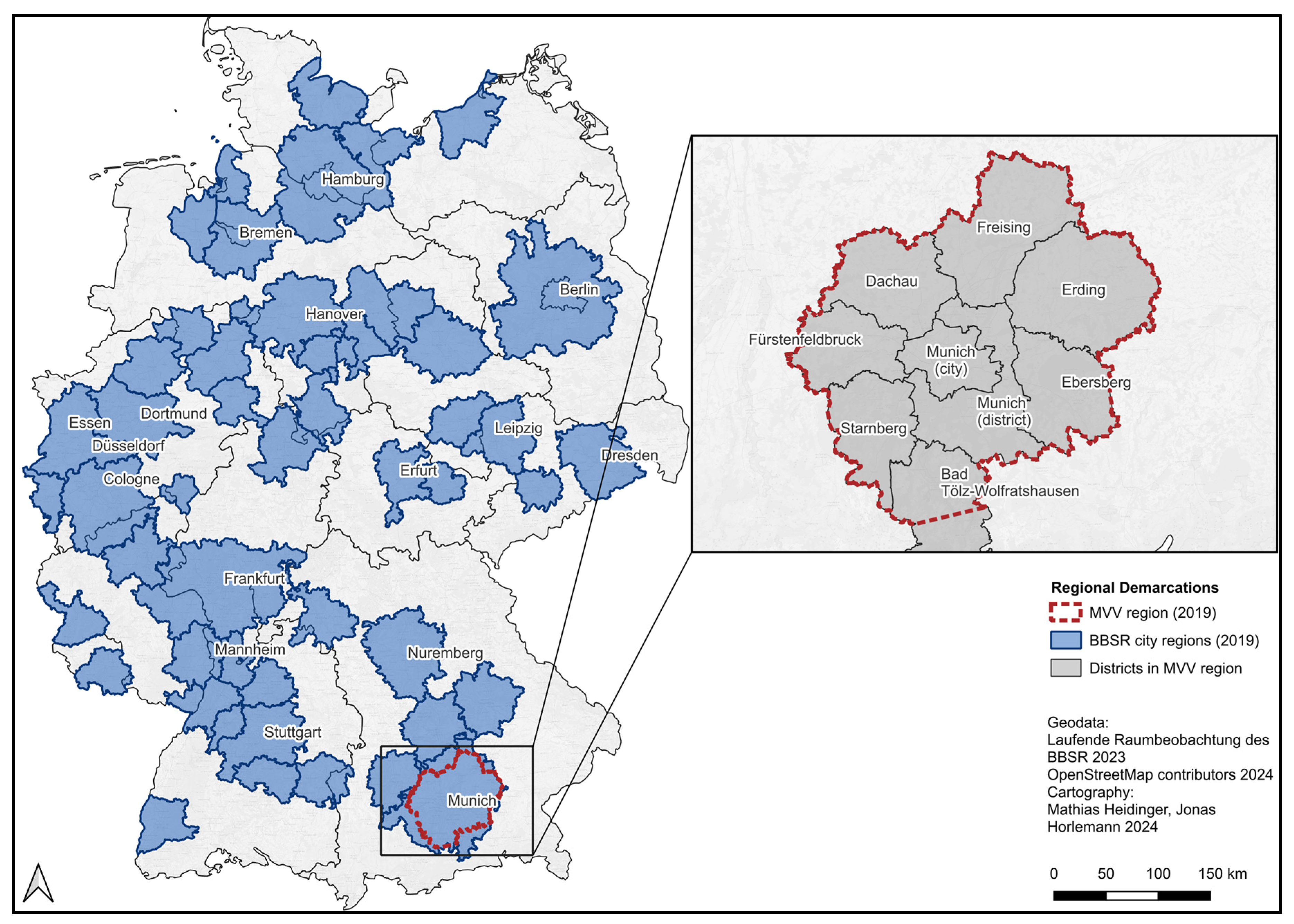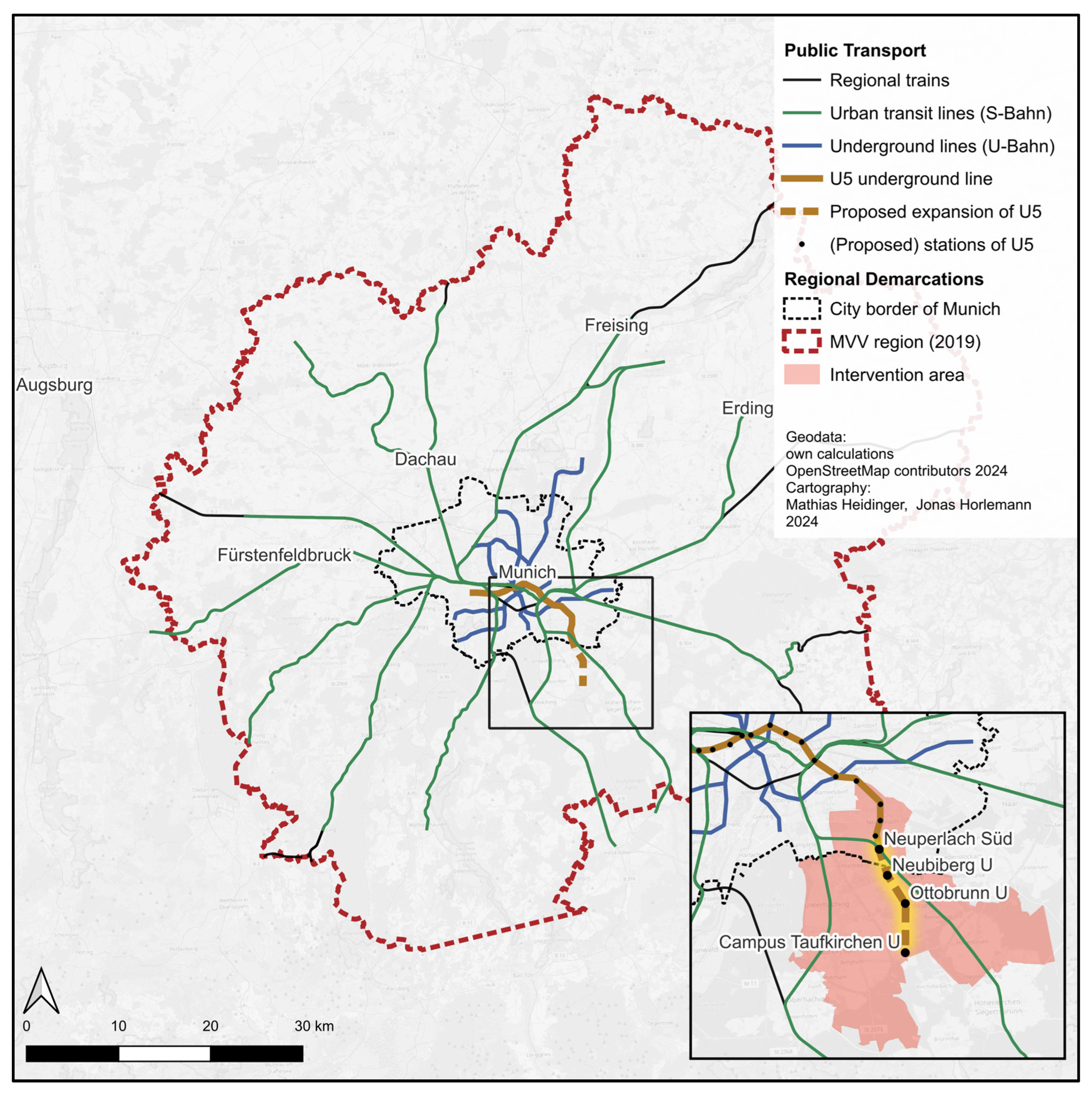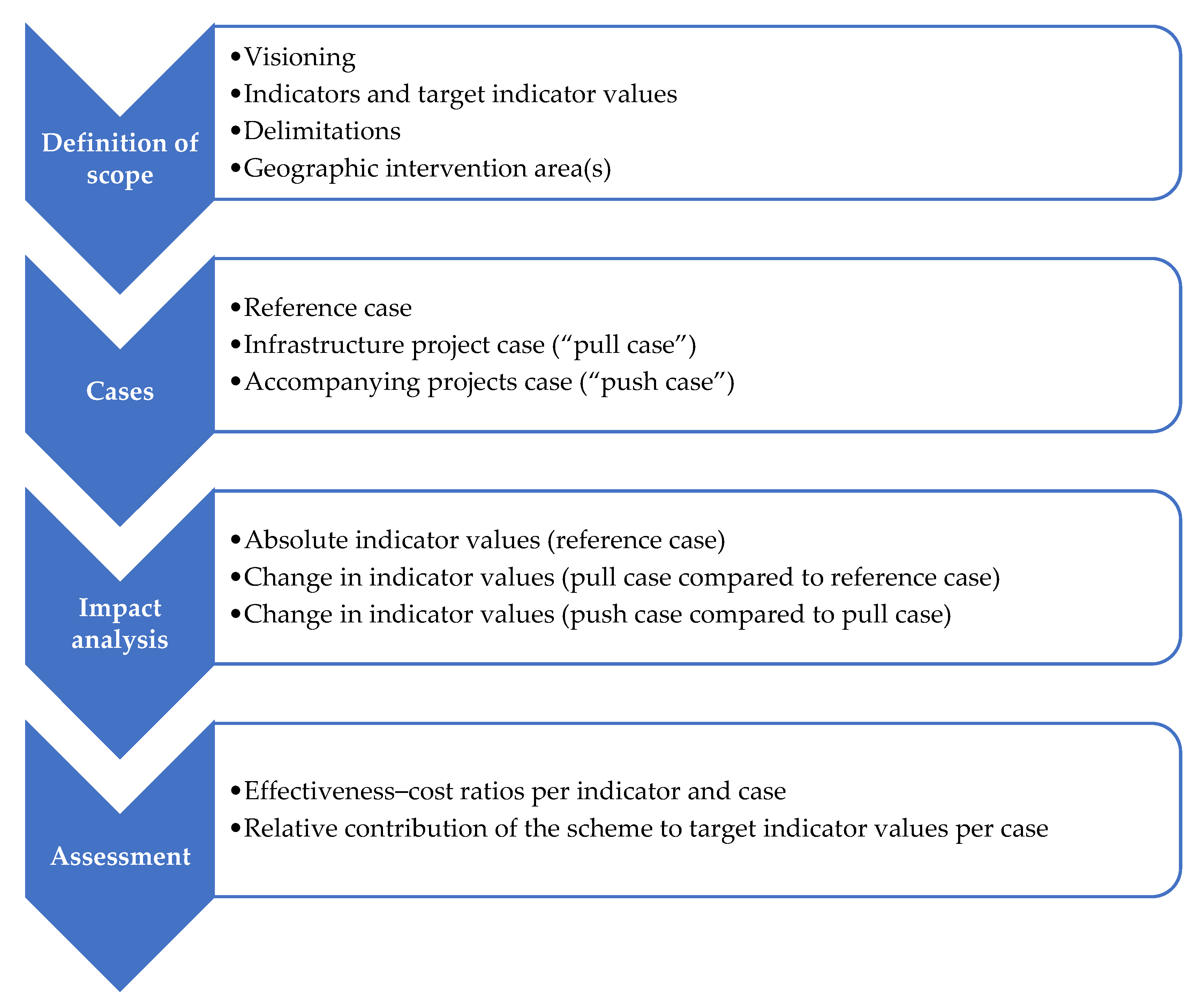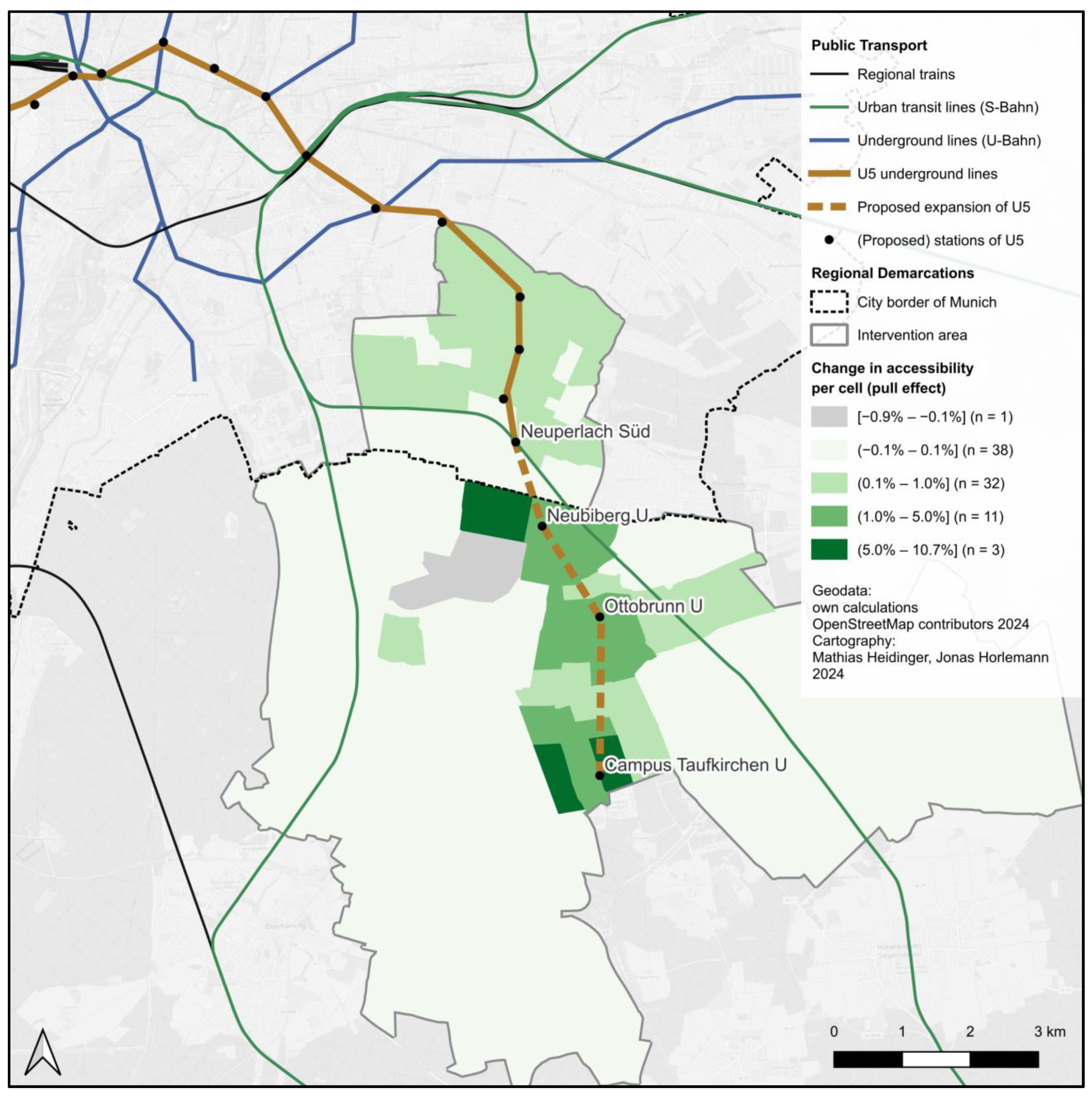Introducing a Novel Framework for the Analysis and Assessment of Transport Projects in City Regions
Abstract
1. Introduction
2. Background and Context
2.1. Theoretical Background
2.2. New Avenues in Transport Appraisal
How can we combine alternative methodologies such as accessibility analyses, quantitative targets, and cost-effectiveness analysis to develop and test an appraisal methodology for packages of transport measures in city regions?
2.3. Case Study: The U5 Southeast Underground Line Extension in the Munich City Region
3. Methodology
3.1. Definition of Scope
- Geographical area: Due to data availability, communicability, and functional adequacy (see Section 2.3), we use the MVV region in 2019 as a spatial delimitation.
- Intervention area: For testing the proposed methodology, one intervention area within the MVV region is defined as a sub-unit of the geographical area. This intervention area covers the geographical area of the U5 southeast extension and the area for accompanying push measures. It is shown in Figure 2.
- Years: The base year of the analysis is 2019. Indicator values are calculated for the years 2019 to 2055. A legal target for the climate neutrality of the transport system in Germany by 2045 has been established [35]. Allowing for some additional years of possible overshoot, we use the period until 2055 as the planning horizon for the MVV region. However, some compromises due to data availability are necessary. For instance, accessibility indicators are only modelled for the forecast year 2035. It was chosen for reasons of data availability. Additionally, this forecast year is currently used for official transport project assessments in the MVV region, ensuring comparability. For the years beyond 2035, travel demand projections were not available. Therefore, the transport demand impacts of the U5 southeast extension and accompanying push measures are assumed constant for the rest of the project’s life cycle.
- Types of transport: We only consider passenger transport in our study due to data availability and the fact that we assess a scheme with a public transport project that has a negligible impact on freight transport.
- Transport relations: Our study aims to analyse and assess the transport-related impacts within the MVV region. Hence, we only consider the transport relations starting and ending within the MVV region. The case study does not consider the through, inbound, and outbound traffic of the MVV region. In Germany, long-distance road, rail, and waterway networks are planned on a national scale in the process of the German Federal Transport Infrastructure Plan [36]. Consequently, if the methodology were applied at a broader geographic scale or even at the national level, then more transport relations would be included within the scope of assessment.
3.1.1. Accessibility to Jobs
3.1.2. Carbon Dioxide Emissions
3.1.3. Primary Energy Consumption
3.1.4. Costs
- Public transit operating costs;
- Infrastructure costs: project-specific investment costs, reinvestment, and residual values in 2055 according to standardised life cycles per infrastructure component;
- Maintenance cost: according to standardised maintenance cost rates per infrastructure component.
3.2. Cases
- Changes in the public transit network due to the U5 southeast extension in 2035 (in terms of additional underground stations, changes in the operating concept of underground services, changes in bus services);
- Resulting changes in the travel impedance matrices;
- Resulting changes in the travel demand matrices;
- Resulting changes in carbon dioxide emissions and primary energy consumption;
- Changes in investment, maintenance, and operating costs.
- Shows where these push measures could be implemented from a regional accessibility perspective;
- Shows their effect on mobility behaviour, carbon dioxide emissions, and primary energy consumption in relation to the costs of the scheme. Other positive impacts of push measures on urban environments, quality of life, and quality of stay are neglected here, as well as possible negative impacts on the economic welfare of car users.
- 1.
- The effect of the U5 project on public transit accessibility in the intervention area is determined by calculating the change in public transit accessibility in the pull case compared to the reference case (rc). For this, the modal share in Formula (1) is neglected, and only accessibility for k = transit is calculated per cell:
- 2.
- can be expressed as a change of “weighted average public transit impedance in minutes per cell in the intervention area to reach jobs in the MVV region” by using a logarithmic transformation of accessibility per cell:
- 3.
- Next, this accessibility improvement in the public transit system is regarded as a potential to make car traffic per transport cell less attractive by implementing push measures. Hence, in the first term of Equation (7), car impedance surcharges per cell are set equal to the negative change in weighted average public transit impedance per cell in the intervention area. In the second term of Equation (7), this is scaled by the ratio of transit demand and car demand ( = travel demand per origin–destination relation in passengers per weekday) per cell:If a transport cell has a high ratio of transit to car demand, this indicates that sufficient services are available. It is, therefore, more accessible for car users to shift to public transit. Thus, these transport cells receive a higher car impedance surcharge in the push case. Instead, if the ratio of transit to car demand per transport cell is low, the car impedance surcharge is lower. Thereby, push measures are assigned to cells that both benefit from the pull project and allow travellers to shift to public transit.
- 4.
- In the final step, car impedance surcharges are converted into car travel time extensions in the push case, where is a conversion factor from the transport model:
- Administrative responsibilities: Since all projects in a package are assessed jointly, the implementation of the entire package must be guaranteed. This is most likely if the projects fall under the responsibility of certain administrative authorities—municipalities or city districts—that can credibly guarantee implementation.
- Communication with citizens and various stakeholders: The acceptance of accompanying projects, e.g., street redesigns and parking reductions, is likely to increase if they are associated with improvements from a public transport infrastructure project. The idea of acceptance is also reflected in the concept of “push and pull measures” [34] or “carrots and sticks” [42].
- Strategic action and scaling for the city region: Geographically distinct intervention areas create the opportunity to develop a transport programme for the city region on a larger scale. Our proposed framework can assist this process by building on the analyses and assessment results to rank and prioritise schemes for many intervention areas.
- Clear attribution of impacts: There is a clear causal relationship between the transport project package and resulting changes in travel demand, carbon dioxide emissions, and primary energy consumption. It is irrelevant where the impacts occur. Therefore, we functionally attribute all indicator impacts to the project package of one intervention area, even if parts of the impacts occur outside the intervention area. For instance, imagine one person who lives inside the intervention area and whose workplace is outside the intervention area. Due to the scheme, this person might shift from using a car to taking public transit for their trip to work. Then, a part of the journey occurs within the intervention area and another part outside. In our framework, the reduction in car vehicle kilometres from the entire journey length would be functionally attributed to the transport scheme in the intervention area. This makes it possible to analyse and assess measures in several regional intervention areas and clearly attribute their effects without double-counting. Hence, stakeholders in a city region could develop project and policy packages for distinct intervention areas, and the methodology could assess the contribution of different intervention areas to region-wide targets for improving the plans and ranking them.
4. Findings
4.1. Target Indicator Values
4.2. Impact Analysis
4.3. Assessment
5. Discussion
- A new perspective complements mere forecasting approaches: Assuming all regulations and expected transport developments manifest in a projected reference case, the proposed methodology determines a city region’s residual scope of action to achieve its target indicator values.
- A new key analysis variable focuses on transport supply rather than transport demand: In this paper, the key indicator is an accessibility index. Hence, the approach becomes less demand-oriented and more focused on accessibility objectives.
- A new sequential calculation of three cases fosters integrated planning and assessment: The proposed methodology calculates a third case to bundle pull and push measures into a combined package for a specific intervention area of a city region. Additionally, the method breaks the vicious circle of infrastructure provision and induced traffic. As defined in the feedback model by Wegener [51], lower travel times and costs due to transport projects tend to increase the attractiveness of movement, thus changing location decisions, inducing movement, and, hence, new transport infrastructure construction. Mainstream transport appraisal typically neglects dynamic feedback loops due to transport and land use interactions by focusing on the user benefits of reduced travel times. This paper’s methodology can help avoid the transportation and land use feedback loop by holding accessibility constant, thereby counter-balancing accessibility improvements due to faster connections with push measures.
6. Conclusions
Author Contributions
Funding
Data Availability Statement
Acknowledgments
Conflicts of Interest
Appendix A
References
- Banister, D. The Sustainable Mobility Paradigm. Transp. Policy 2008, 15, 73–80. [Google Scholar] [CrossRef]
- Annema, J.A.; Mouter, N.; Razaei, J. Cost-Benefit Analysis (CBA), or Multi-Criteria Decision-Making (MCDM) or Both: Politicians’ Perspective in Transport Policy Appraisal. Transp. Res. Procedia 2015, 10, 788–797. [Google Scholar] [CrossRef]
- Mackie, P.; Worsley, T.; Eliasson, J. Transport Appraisal Revisited. Res. Transp. Econ. 2014, 47, 3–18. [Google Scholar] [CrossRef]
- Beukers, E.; Bertolini, L.; Te Brömmelstroet, M. Why Cost Benefit Analysis Is Perceived as a Problematic Tool for Assessment of Transport Plans: A Process Perspective. Transp. Res. Part A Policy Pract. 2012, 46, 68–78. [Google Scholar] [CrossRef]
- Hickman, R.; Dean, M. Incomplete Cost—Incomplete Benefit Analysis in Transport Appraisal. Transp. Rev. 2018, 38, 689–709. [Google Scholar] [CrossRef]
- Metz, D. The Myth of Travel Time Saving. Transp. Rev. 2008, 28, 321–336. [Google Scholar] [CrossRef]
- Metz, D. Response to the Responses. Transp. Rev. 2008, 28, 713–715. [Google Scholar] [CrossRef]
- Mouter, N. Standard Transport Appraisal Methods. In Advances in Transport Policy and Planning; Mouter, N., Ed.; Elsevier: Cambridge, MA, USA, 2021; Volume 7, pp. 1–7. ISBN 978-0-323-85559-4. [Google Scholar]
- Berechman, J. Welfare Foundations of Project Appraisal. In The Evaluation of Transportation Investment Projects; Routledge: New York, NY, USA, 2009; pp. 27–47. ISBN 978-0-415-77715-5. [Google Scholar]
- Karlström, A. Appraisal. In Handbook of Choice Modelling; Hess, S., Daly, A., Eds.; Edward Elgar Publishing: Cheltenham, UK, 2014; ISBN 978-1-78100-315-2. [Google Scholar]
- Standing Advisory Committee on Trunk Road Assessment (SACTRA). Transport and the Economy: Full Report (SACTRA); The Stationery Office Books: London, UK, 1999; ISBN 0-11-753507-9. [Google Scholar]
- Jara-Diaz, S.R. On the Relation between Users’ Benefits and the Economic Effects of Transportation Activities. J. Reg. Sci. 1986, 26, 379–391. [Google Scholar] [CrossRef]
- Holvad, T.; Leleur, S. Transport Projects and Wider Economic Impacts. In Handbook on Transport and Development; Hickman, R., Givoni, M., Bonilla, D., Banister, D., Eds.; Edward Elgar Publishing: Cheltenham, UK, 2015; pp. 259–272. ISBN 978-0-85793-726-1. [Google Scholar]
- Laird, J.J.; Venables, A.J. Transport Investment and Economic Performance: A Framework for Project Appraisal. Transp. Policy 2017, 56, 1–11. [Google Scholar] [CrossRef]
- Wangsness, P.B.; Rødseth, K.L.; Hansen, W. A Review of Guidelines for Including Wider Economic Impacts in Transport Appraisal. Transp. Rev. 2017, 37, 94–115. [Google Scholar] [CrossRef]
- Goulden, M.; Ryley, T.; Dingwall, R. Beyond ‘Predict and Provide’: UK Transport, the Growth Paradigm and Climate Change. Transp. Policy 2014, 32, 139–147. [Google Scholar] [CrossRef]
- Macharis, C.; de Witte, A.; Ampe, J. The Multi-Actor, Multi-Criteria Analysis Methodology (MAMCA) for the Evaluation of Transport Projects: Theory and Practice. J. Adv. Transp. 2009, 43, 183–202. [Google Scholar] [CrossRef]
- Mouter, N.; Koster, P.; Dekker, T. Contrasting the Recommendations of Participatory Value Evaluation and Cost-Benefit Analysis in the Context of Urban Mobility Investments. Transp. Res. Part A Policy Pract. 2021, 144, 54–73. [Google Scholar] [CrossRef]
- Hickman, R. The Gentle Tyranny of Cost–Benefit Analysis in Transport Appraisal. In Transport Matters; Policy Press: Bristol, UK, 2019; pp. 131–152. ISBN 978-1-4473-2955-8. [Google Scholar]
- Banister, D.; Hickman, R. Transport Futures: Thinking the Unthinkable. Transp. Policy 2013, 29, 283–293. [Google Scholar] [CrossRef]
- Mackie, P. Who Knows Where the Time Goes? A Response to David Metz. Transp. Rev. 2008, 28, 692–694. [Google Scholar] [CrossRef]
- Van Wee, B.; Rietveld, P. ‘The Myth of Travel Time Saving’: A Comment. Transp. Rev. 2008, 28, 688–692. [Google Scholar] [CrossRef]
- Givoni, M. A Comment on ‘The Myth of Travel Time Saving’. Transp. Rev. 2008, 28, 685–688. [Google Scholar] [CrossRef]
- Cervero, R. Going beyond Travel Time Savings; World Bank: Washington, DC, USA, 2011. [Google Scholar]
- Bundesinstitut für Bau-, Stadt- und Raumforschung (BBSR). Laufende Raumbeobachtung, Raumgliederungen auf Regionsbasis: Großstadtregionen 2019. Available online: https://www.bbsr.bund.de/BBSR/DE/forschung/raumbeobachtung/downloads/archiv/download-referenzen.html (accessed on 5 January 2024).
- OpenStreetMap Contributors. OpenStreetMap 2024. Available online: https://www.openstreetmap.org/copyright/en (accessed on 29 January 2024).
- Thierstein, A.; Wulfhorst, G.; Bentlage, M.; Klug, S.; Gilliard, L.; Ji, C.; Steiner, H.; Sterzer, L.; Wenner, F.; Zhao, J. WAM Wohnen Arbeiten Mobilität—Veränderungsdynamik und Entwicklungsoptionen für die Metropolregion München (Living Working Mobility—Change Dynamics and Development Options for the Munich Metropolitan Region); Technical University of Munich: Munich, Germany, 2016. [Google Scholar]
- Belz, J.; Brand, T.; Eggs, J.; Ermes, B.; Follmer, R.; Gruschwitz, D.; Kellerhoff, J.; Pirsig, T.; Roggendorf, M. Mobilität in Deutschland—MiD Regionalbericht Stadt München, Münchner Umland und MVV-Verbundraum. Studie von Infas, DLR, IVT und Infas 360 im Auftrag des Bundesministeriums Für Verkehr und Digitale Infrastruktur (FE-Nr. 70.904/15); Bundesministerium für Verkehr und digitale Infrastruktur: Bonn, Germany; Berlin, Germany, 2019.
- Bundesinstitut für Bau-, Stadt- und Raumforschung (BBSR). Zahl der Pendlerinnen und Pendler gestiegen (Increase in the Number of Commuters). Available online: https://www.bbsr.bund.de/BBSR/DE/startseite/topmeldungen/pendeln-2022.html (accessed on 2 January 2024).
- Landeshauptstadt München, Referat für Stadtplanung und Bauordnung. Zwischenbericht Nahverkehrsplan (Interim Report Local Transport Plan); Landeshauptstadt München, Referat für Stadtplanung und Bauordnung: Munich, Germany, 2021.
- Plan:Mobil; Mathias Schmechtig NahverkehrsConsult. Fortschreibung des Nahverkehrsplans für den Landkreis München (Update of the Local Transport Plan for the District of Munich); Landratsamt München: Munich, Germany, 2020. [Google Scholar]
- Munich Transport and Tariff Association (MVV). MVV Database 2019–2035 (Unpublished); Munich Transport and Tariff Association (MVV): Munich, Germany, 2022. [Google Scholar]
- Intraplan. Benefit-Cost-Analysis U5 South, Commissioned by the District of Munich (Unpublished); Intraplan: Munich, Germany, 2023. [Google Scholar]
- Marshall, S. Introduction: Travel Reduction—Means and Ends. Built Environ. 1999, 25, 88–93. [Google Scholar]
- Federal Climate Change Act of 12 December 2019 (Federal Law Gazette I, p. 2513), as Last Amended by Article 1 of the Act of 18 August 2021 (Federal Law Gazette I, p. 3905). 2021. Available online: https://www.gesetze-im-internet.de/englisch_ksg/englisch_ksg.html (accessed on 7 March 2024).
- Fichert, F. Transport Policy Planning in Germany—An Analysis of Political Programs and Investment Masterplans. Eur. Transp. Res. Rev. 2017, 9, 28. [Google Scholar] [CrossRef]
- Intraplan; VWI Stuttgart. German National Guideline for Standardised Appraisal of Public Transport Infrastructure Investments, Version 2016+, Prepared on Behalf of the German Ministry for Digital and Transport; Intraplan: Munich, Germany; VWI Stuttgart: Stuttgart, Germany, 2022. [Google Scholar]
- Pereira, R.H.M.; Saraiva, M.; Herszenhut, D.; Braga, C.K.V.; Conway, M.W. R5r: Rapid Realistic Routing on Multimodal Transport Networks with R5 in R. Findings 2021, 1–10. [Google Scholar] [CrossRef]
- Nobis, C.; Kuhnimhof, T. Mobilität in Deutschland—Mid, Ergebnisbericht, Studie von infas, DLR, IVT und infas 360 im Auftrag des Bundesministers für Verkehr und digitale Infrastruktur (FE-Nr. 70.904/15); Bundesministerium für Verkehr und Digitale Infrastruktur: Berlin, Germany, 2018.
- Bavarian Climate Change Act of 23 November 2020 (Bavarian Law Gazette, p. 598, 656, BayRS 2129-5-1-U), as Last Amended by Article 1 of the Act of 23 December 2022 (Bavarian Law Gazette, p. 704). 2022. Available online: https://www.gesetze-bayern.de/Content/Document/BayKlimaG/true (accessed on 7 March 2024).
- German Energy Efficiency Act of 13 November 2023 (Federal Law Gazette I, p. 309). 2023. Available online: https://www.gesetze-im-internet.de/enefg/BJNR1350B0023.html (accessed on 7 March 2024).
- Meyer, M.D. Demand Management as an Element of Transportation Policy: Using Carrots and Sticks to Influence Travel Behavior. Transp. Res. Part A Policy Pract. 1999, 33, 575–599. [Google Scholar] [CrossRef]
- Wardman, M. Meta-Analysis of British Time-Related Demand Elasticity Evidence: An Update. Transp. Res. Part A Policy Pract. 2022, 157, 198–214. [Google Scholar] [CrossRef]
- Acutt, M.Z.; Dodgson, J.S. Cross-Elasticities of Demand for Travel. Transp. Policy 1995, 2, 271–277. [Google Scholar] [CrossRef]
- Flügel, S.; Fearnley, N.; Toner, J. What Factors Affect Cross-Modal Substitution?—Evidences from the Oslo Area. Int. J. Transp. Dev. Integr. 2018, 2, 11–29. [Google Scholar] [CrossRef]
- Svensson, M.; Hultkrantz, L. A Comparison of Cost-Benefit and Cost-Effectiveness Analysis in Practice: Divergent Policy Practices in Sweden. Nord. J. Heal. Econ. 2017, 5, 41–53. [Google Scholar] [CrossRef]
- Willan, A.R.; Briggs, A.H. Cost-Effectiveness Analysis. In Statistical Analysis of Cost-Effectiveness Data; Statistics in Practice; Wiley: Chichester, UK, 2006; pp. 43–65. ISBN 978-0-470-85628-4. [Google Scholar]
- Nissen, C.; Gores, S.; Healy, S.; Hermann, H. Trends and Projections in the EU ETS in 2023, The EU Emissions Trading System in Numbers; European Environment Agency: Copenhagen, Denmark, 2023.
- Municipal Transport Financing Act (Gemeindeverkehrsfinanzierungsgesetz) in the Version Published on January 28, 1988 (Federal Law Gazette I P. 100), Which Was Last Amended by Article 323 of the Ordinance of June 19, 2020 (Federal Law Gazette I p. 1328). 2020. Available online: https://www.gesetze-im-internet.de/gvfg/index.html#BJNR002390971BJNE000101307 (accessed on 7 March 2024).
- Bundesamt für Raumentwicklung (ARE). Programm Agglomerationsverkehr (Agglomeration Traffic Programme). Available online: https://www.are.admin.ch/are/de/home/verkehr-und-infrastruktur/programme-und-projekte/agglomerationsprogramme-verkehr-und-siedlung.html (accessed on 3 January 2024).
- Wegener, M. Overview of Land Use Transport Models. In Handbook of Transport Geography and Spatial Systems; Hensher, D.A., Button, K.J., Haynes, K.E., Stopher, P.R., Eds.; Emerald Group Publishing Limited: Leeds, UK, 2004; pp. 127–146. ISBN 978-1-61583-253-8. [Google Scholar]







| Traditional Transport Appraisal | Promising Alternative | |
|---|---|---|
| Perspective: | Forecasting | Forecasting + targets |
| Calculation of scheme impacts: | Ceteris paribus comparison: reference case/project case | Sequential comparison of three cases: reference case/project case (“pull”)/project case with accompanying measures (“push”) |
| Key variable: | Travel demand | Accessibility |
| Metric: | Economic welfare: transport consumer and producer surpluses, plus technological externalities | Cost-effectiveness |
| Formal assessment: | CBA 1 | CEA 2, plus contribution of the scheme to achieve target indicators |
| Underlying paradigm: | “Predict and provide” as long as benefits exceed costs | Sustainable mobility |
| Research priorities: | Complete assessment of all scheme impacts, including wider economic impacts; Spatial and social incidence of costs and benefits | Testing of multi-faceted approaches of integrated planning to break the vicious circle of infrastructure investment, spatial relocation, induced traffic, and the resulting need for more infrastructure investment; Process-orientation instead of project-orientation: regional programmes to achieve quantitative targets instead of isolated planning of individual schemes; Project packages (“push and pull”) |
| Indicator | Description |
|---|---|
| Accessibility to jobs | Index describing the accessibility of the population to workplaces in the MVV region by car, public transit, and bike in 2035. |
| Carbon dioxide emissions | Carbon dioxide emissions from passenger transport within the MVV region. |
| Primary energy consumption | Primary energy consumption from passenger transport within the MVV region. |
| Costs | Costs for infrastructure investment, maintenance, and operation, expressed as NPV in EUR at 2016 prices. |
| Unit | Target Indicator Value | Reference Case | Change in Pull Case vs. Reference Case | Change in Push Case vs. Pull Case | Change in Push Case vs. Reference Case | |
|---|---|---|---|---|---|---|
| Forecast for 2035: | ||||||
| Accessibility to jobs 1 | [-] | 21.2145 | 21.2145 | +0.0178 | −0.0178 | 0 |
| Total for the assessment period 2019 to 2055: | ||||||
| Carbon dioxide emissions 2 | [kt CO2] | 46,130 | 75,109 | −18 | −9 | −27 |
| Primary energy consumption 2 | [TJ] | 995,210 | 1,187,587 | −214 | −181 | −395 |
| Costs 3 | [million EUR2016] | not calculated | not calculated | +283 | +8 | +291 |
| Effectiveness-Cost Ratio 1 | Cost-Effectiveness Ratio 2 | Contribution to Close the Target Gap 3 | |
|---|---|---|---|
| Carbon dioxide emissions 4 | |||
| Pull effect | −63 t CO2/million EUR2016 | 15,804 EUR2016/t CO2 | 0.06% |
| Push effect | −1084 t CO2/million EUR2016 | 922 EUR2016/t CO2 | 0.03% |
| Pull + Push effect | −92 t CO2/million EUR2016 | 10,858 EUR2016/t CO2 | 0.09% |
| Primary energy consumption 4 | |||
| Pull effect | −756 GJ/million EUR2016 | 1323 EUR2016/GJ | 0.11% |
| Push effect | −22,049 GJ/million EUR2016 | 45 EUR2016/GJ | 0.09% |
| Pull + Push effect | −1357 GJ/million EUR2016 | 737 EUR2016/GJ | 0.20% |
| Criteria | Advantages | Restrictions |
|---|---|---|
| 1. Framework | Flexible and scalable for developing transport programmes for city regions | Spatial scale and integrated project packages often inconsistent with current planning and funding frameworks |
| 2. Indicators | Revealing quantitative targets and the contribution to these targets | Social distribution of effects neglected; Methodology only suitable for quantitative indicators |
| 3. Assessment | New premise: achieving quantitative targets with cost-effective means | Incomplete assessment, no weighting and no aggregate indicators for decision support |
| 4. Case Study | Possible adaptation: accessibility targets based on urban structure | Status quo bias due to the target of constant accessibility at the level of the reference case |
| 5. Modelling | Combination of accessibility improvements due to public transport investment with spatial push measures is transferrable to other contexts | Accessibility not differentiated according to specific user groups; Push measures (cell-specific car travel time extensions) still to be translated into concrete measures for implementation; So far, only cell-specific and no relation-specific push measures considered |
| 6. Results | CO2 mitigation potential by public transport infrastructure projects seems low | Various other justifications for transport schemes not reflected in the indicators of the case study |
| 7. Contribution to sustainable mobility planning | Deduction of target indicator values to complement mere forecasting approaches; Analysis focusing on transport supply (accessibility) rather than transport demand; Fostering integrated planning | Methodology not backed by theory about the determinants and distributional aspects of welfare in the realm of transport |
Disclaimer/Publisher’s Note: The statements, opinions and data contained in all publications are solely those of the individual author(s) and contributor(s) and not of MDPI and/or the editor(s). MDPI and/or the editor(s) disclaim responsibility for any injury to people or property resulting from any ideas, methods, instructions or products referred to in the content. |
© 2024 by the authors. Licensee MDPI, Basel, Switzerland. This article is an open access article distributed under the terms and conditions of the Creative Commons Attribution (CC BY) license (https://creativecommons.org/licenses/by/4.0/).
Share and Cite
Horlemann, J.; Heidinger, M.; Wenner, F.; Thierstein, A. Introducing a Novel Framework for the Analysis and Assessment of Transport Projects in City Regions. Sustainability 2024, 16, 2349. https://doi.org/10.3390/su16062349
Horlemann J, Heidinger M, Wenner F, Thierstein A. Introducing a Novel Framework for the Analysis and Assessment of Transport Projects in City Regions. Sustainability. 2024; 16(6):2349. https://doi.org/10.3390/su16062349
Chicago/Turabian StyleHorlemann, Jonas, Mathias Heidinger, Fabian Wenner, and Alain Thierstein. 2024. "Introducing a Novel Framework for the Analysis and Assessment of Transport Projects in City Regions" Sustainability 16, no. 6: 2349. https://doi.org/10.3390/su16062349
APA StyleHorlemann, J., Heidinger, M., Wenner, F., & Thierstein, A. (2024). Introducing a Novel Framework for the Analysis and Assessment of Transport Projects in City Regions. Sustainability, 16(6), 2349. https://doi.org/10.3390/su16062349






